NCERT Solutions Class 10 Maths Chapter 12: Areas Related To CirclesExercise 12.1Unless stated otherwise, use π = 22/7 1. The radii of two circles are 19 cm and 9 cm respectively. Find the radius of the circle which has circumference equal to the sum of the circumferences of the two circles. Solution Let the radius of the required circle be x. Circumference of the first circle = 2πR = 2 × 22/7 × 19 = 836/7 cm Circumference of the second circle = 2πr = 2 × 22/7 × 9 = 396/7 cm Circumference of the third circle = 2πR + 2πr = 836/7 + 396/7 cm = 1232/7 cm 2πx = 1232/7 2 × 22x/7 = 1232/7 44x = 1232 x = 28 cm Hence, the radius of the required circle is 28 cm. 2. The radii of two circles are 8 cm and 6 cm respectively. Find the radius of the circle having area equal to the sum of the areas of the two circles. Solution Let the radius of the required circle be x. Area of the first circle = πR2 = 22/7 × 82 = 22/7 × 64 = 1408/7 cm2 Area of the second circle = πr2 = 22/7 × 62 = 792/7 cm Area of the third circle = πR2 + πr2 = 1408/7 + 792/7 cm2 = 2200/7 cm πx2 = 2200/7 22(x2)/7 = 2200/7 22x2 = 2200 x2 = 100 x = 10 cm Hence, the radius of the required circle is 10 cm. 3. Fig. 12.3 depicts an archery target marked with its five scoring regions from the centre outwards as Gold, Red, Blue, Black and White. The diameter of the region representing Gold score is 21 cm and each of the other bands is 10.5 cm wide. Find the area of each of the five scoring regions. 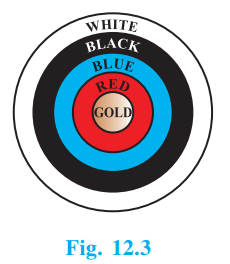
Solution I. Radius of Gold region = r1 = 21/2 = 10.5 cm Area of Gold region = r2 = πr12 = 22/7 × (10.5)2 = 22/7 × 110.25 = 22(15.75) = 346.5 cm2 II. Radius of region upto Red = r2 = 10.5 + 10.5 = 21 cm Area of Red region = πr22 - πr12 = 22/7 × 212 - 346.5 = 22(63) - 346.5 = 1386 - 346.5 = 1039.5 cm2 III. Radius of region upto Blue = r3 = 21 + 10.5 = 31.5 cm Area of Blue region = πr32 - πr22 = 22/7 × (31.5)2 - 1386 = 22(141.75) - 1386 = 3118.5 - 1386 = 1732.5 cm2 IV. Radius of region upto Black = r4 = 31.5 + 10.5 = 42 cm Area of Black region = πr42 - πr32 = 22/7 × (42)2 - 3118.5 = 22(252) - 3118.5 = 5544 - 3118.5 = 2425.5 cm2 V. Radius of region upto White = r5 = 42 + 10.5 = 52.5 cm Area of White region = πr52 - πr42 = 22/7 × (52.5)2 - 5544 = 22(393.75) - 5544 = 8662.5 - 5544 = 3118.5 cm2 4. The wheels of a car are of diameter 80 cm each. How many complete revolutions does each wheel make in 10 minutes when the car is travelling at a speed of 66 km per hour? Solution Distance travelled by the car in an hour = 66 km = 66000 m Distance travelled by the car in a minute = 66000/60 = 1100 m Distance travelled by the car in 10 minutes = 1100 × 10 = 11000 m Radius of each wheel = 80/2 = 40 cm = 0.4 m Distance covered by each wheel in one revolution = 2πr = 2 × 22/7 × 0.4 = 17.6/7 m Revolutions required to cover 11000 m = 11000/(17.6/7) = 11000(7)/17.6 = 7000/1.6 = 4375 Hence, each car wheel makes 4375 complete revolutions in 10 minutes when the car is travelling at a speed of 66 km per hour. 5. Tick the correct answer in the following and justify your choice : If the perimeter and the area of a circle are numerically equal, then the radius of the circle is (A) 2 units (B) π units (C) 4 units (D) 7 units Solution Area of the circle = Circumference of the circle πr2 = 2πr r2 = 2r r = 2 units Hence, (A) is the correct answer. Exercise 12.2Unless stated otherwise, use π = 22/7 1. Find the area of a sector of a circle with radius 6 cm if angle of the sector is 60°. Solution Angle of the sector of given circle = 60° Area of sector = (θ/360°) × πr2 = (60°/360°) × 22/7 × 62 = 1/6 × 22/7 × 62 = 22/7 × 6 = 132/7 cm2 2. Find the area of a quadrant of a circle whose circumference is 22 cm. Solution Circumference of the given circle = 22 cm 2πr = 22 2 × 22/7 × r = 22 2r = 7 r = 7/2 cm Area of quadrant of a circle = (1/4) × πr2 = 1/4 × 22/7 × (7/2)2 = 11/2 × 7/4 = 77/8 cm2 3. The length of the minute hand of a clock is 14 cm. Find the area swept by the minute hand in 5 minutes. Solution Length of the minute hand of clock = r = 14 cm Area swept by the minute hand in 60 minutes = πr2 = 22/7 × 142 = 22 × 2 × 14 = 616 cm2 Angle covered by the minute hand in 60 minutes = 360° Angle covered by the minute hand in 5 minutes = 360°/60° × 5 = 30° Area swept by minute hand of the clock in 5 minutes = (θ/360°) × πr2 = (30°/360°) × 616 = 1/12 × 616 = 154/3 cm2 4. A chord of a circle of radius 10 cm subtends a right angle at the centre. Find the area of the corresponding : (i) minor segment (ii) major sector. (Use π = 3.14) Solution Radius of the circle = 10 cm Area of the circle = πr2 = 3.14 × 102 = 314 cm2 (i) Area of minor segment = (θ/360°) × πr2 = (90°/360°) × 314 = 1/4 × 314 = 76 cm2 (ii) Area of major segment = ((360° - θ)/360°) × πr2 = (270°/360°) × 314 = 3/4 × 314 = 228 cm2 5. In a circle of radius 21 cm, an arc subtends an angle of 60° at the centre. Find:
Solution (i) Circumference of the circle = 2πr = 2 × 22/7 × 21 = 2 × 22 × 3 = 132 cm Length of the arc = (θ/360°) × 2πr = (60°/360°) × 132 = 1/6 × 132 = 22 cm (ii) Area of the circle = πr2 = 22/7 × 212 = 22 × 3 × 21 = 1386 cm2 Area of the sector formed by the arc = (θ/360°) × πr2 = 1/6 × 1386 = 231 cm2 (iii) Area of the segment = Area of the sector - Area of triangle AOB = 231 - √3/4 × r2 (AOB is an equilateral triangle as two sides are equal with angle 60°) = 231 - √3/4 × 212 = 231 - 441√3/4 = (924 - 441√3)/4 cm2 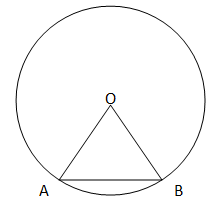
6. A chord of a circle of radius 15 cm subtends an angle of 60° at the centre. Find the areas of the corresponding minor and major segments of the circle. (Use π = 3.14 and √3 = 1.73). Solution 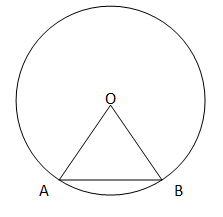
Area of the circle = πr2 = 3.14 × 152 = 3.14 × 225 = 706.5 cm2 Area of the sector = (θ/360°) × πr2 = (60°/360°) × 706.5 = 1/6 × 706.5 = 706.5/6 cm2 Area of the minor segment = Area of sector - Area of triangle AOB Since, two sides are equal (both radii of same circle) and their angle is 60° therefore, AOB is an equilateral triangle. Area of the minor segment = 706.5/6 - √3/4 × 152 = 706.5/6 - 1.73/4 × 225 = 706.5/6 - 97.31 = 122.64/6 = 20.44 cm2 Area of major segment = Area of circle - Area of minor segment = 706.5 - 20.44 = 686.06 cm2 7. A chord of a circle of radius 12 cm subtends an angle of 120° at the centre. Find the area of the corresponding segment of the circle. (Use π = 3.14 and √3 = 1.73). Solution 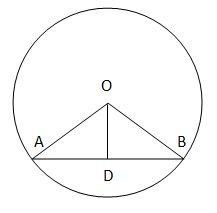
Area of the circle = πr2 = π × 122 = 144π cm2 Area of the sector = (θ/360°) × πr2 = (120°/360°) × 144π = 1/3 × 144π = 48π cm2 Area of the segment = Area of sector - Area of triangle AOB Draw OD ⊥ AB. AOB has two sides equal (both are radii of same circle) so it is an isosceles triangle. Therefore, the perpendicular to the third side will act as the angle bisector for ∠O. In AOB, we have: sin O = AD/OA sin 60° = AD/12 √3/2 = AD/12 6√3 cm = AD Similarly, BD = 6√3 cm. AB = 12√3 cm. Also, cos O = OD/OA (In AOB) cos 60° = OD/12 1/2 = OD/12 6 cm = OD Area of AOB = 1/2 × 12√3 × 6 = 36√3 cm Area of the segment = 48π - 36√3 = 48(3.14) - 36(1.73) =150.72 - 62.28 = 88.44 cm2 Hence, area of the corresponding segment will be 88.44 cm2. 8. A horse is tied to a peg at one corner of a square shaped grass field of side 15 m by means of a 5 m long rope (see Fig. 12.11). Find
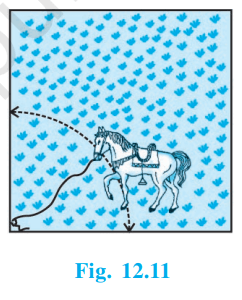
Solution The area in which the horse can graze is a quadrant of a circle with radius equal to the length of the rope. (i) Area of the circle created by the rope = πr2 = (3.14)52 = (3.14)25 = 78.5 m2 Area of the field in which the horse can graze = 1/4 × πr2 = 1/4 × 78.5 = 19.625 m2 (ii) Area of the circle created by the new length of rope = πR2 = (3.14)102 = (3.14)100 = 314 m2 Area of the field which the horse can graze = 1/4 × πR2 = 1/4 × 314 = 78.5 m2 Increase in the grazing area when rope length is increased to 10 m = πR2 - πr2 = 78.5 - 19.625 = 58.875 m2 9. A brooch is made with silver wire in the form of a circle with diameter 35 mm. The wire is also used in making 5 diameters which divide the circle into 10 equal sectors as shown in Fig. 12.12. Find :
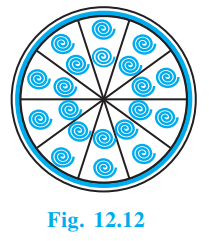
Solution (i) Length of wire used for making the diameters = 35 × 5 = 175 mm = 17.5 cm Length of wire used for making the circle = 2πr = 2 × 22/7 × 35/20 = 2 × 22/7 × 1.75 = 44 × 0.25 = 11 cm Total length of wire used in the brooch = 11 cm. (ii) Area of the circular brooch = πr2 = 22/7 × (1.75)2 = 22 × 0.25 × 1.75 = 9.625 cm2 Area of each sector = 1/10 × πr2 = 1/10 × 9.625 = 0.9625 cm2 or 96.25 mm2 Hence, area of the each of the sectors is 96.25 mm2. 10. An umbrella has 8 ribs which are equally spaced (see Fig. 12.13). Assuming umbrella to be a flat circle of radius 45 cm, find the area between the two consecutive ribs of the umbrella. 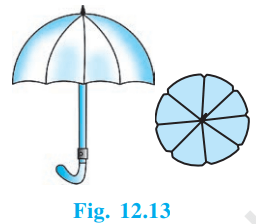
Solution Assuming that the umbrella is a flat circle, the ribs divide it into 8 sectors of equal area. Area of a sector will be the area between two consecutive ribs. Area of the circle = πr2 = 22/7 × 452 = 22/7 × 2025 = 6364.29 cm2 Area of each sector = 1/8 × πr2 = 1/8 × 6364.29 = 795.5 cm2 Hence, the area between two consecutive ribs of the umbrella is 795.5 cm2. 11. A car has two wipers which do not overlap. Each wiper has a blade of length 25 cm sweeping through an angle of 115°. Find the total area cleaned at each sweep of the blades. Solution Area swept by each wiper can be imaginarily extended to form a circle. Radius of this circle = 25 cm Area swept by each wiper through an angle of 360° = Area of the circle = πr2 = 22/7 × 252 = 22/7 × 625 = 1964.29 cm2 Area swept by each wiper through an angle of 115° = (θ/360°) × πr2 = (115°/360°) × πr2 = 23/72 × 1964.29 = 627.48 cm2 Total area swept by the wipers = 2(627.48) = 1254.96 cm2 Hence, the total area cleaned at each swipe of the blade is 1254.96 cm2. 12. To warn ships for underwater rocks, a lighthouse spreads a red colored light over a sector of angle 80° to a distance of 16.5 km. Find the area of the sea over which the ships are warned. (Use π = 3.14) Solution Area covered by the light can be imaginarily extended to form a circle. Radius of the circle = 16.5 km Area of circle = πr2 = (3.14) × (16.5)2 = 854.87 km2 Area of the sector = (θ/360°) × πr2 = (80°/360°) × 854.87 = 2/9 × 854.87 = 189.971 km2 Hence, the area of sea over which ships are warned = 189.97 km2 13. A round table cover has six equal designs as shown in Fig. 12.14. If the radius of the cover is 28 cm, find the cost of making the designs at the rate of 0.35 per cm2. (Use √3 = 1.7) 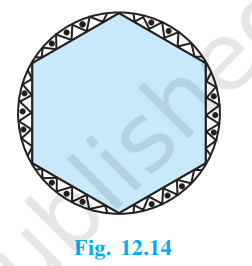
Solution 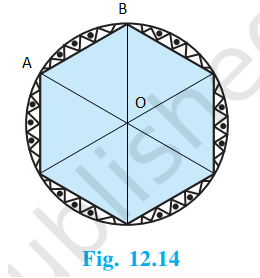
We need to join the edges of each of the designs to the centre of the circle. Area of the circle = πr2 = 22/7 × 282 = 22 × 4 × 28 = 2464 cm2 Area of one sector = 1/6 × πr2 = 1/6 × 2464 = 1232/3 cm2 Since, the circle has six sectors which are equal therefore, the angle of each sector = 360°/6 = 60° Triangle AOB has two equal sides (both are radii of same circle) and their angle is 60°, therefore AOB is an equilateral triangle. Area of triangle AOB = √3/4 × r2 = √3/4 × 282 = √3 × 7 × 28 = 196√3 cm2 Area of each design = Area of the corresponding minor segment = Area of the sector - Area of AOB = 1232/3 - 196√3 = (1232 - 588√3)/3 = (1232 - 999.6)/3 = 232.4/3 cm2 Area of six designs = 6 × 232.4/3 = 464.8 cm2 Cost of making 1 cm2 design = Rs 0.35 Cost of making 464.8 cm2 design = Rs 0.35 × 464.8 = Rs 162.68 Hence, the cost of making the designs on the table cover is Rs 162.68. 14. Tick the correct answer in the following : Area of a sector of angle p (in degrees) of a circle with radius R is (A) p/180 × 2πR (B) p/180 × π R2 (C) p/360 × 2πR (D) p/720 × 2πR2 Solution Area of the sector = (θ/360°) × πR2 = p/360 × πR2 (A) = p/180 × 2πR = p/90 × πR, so (A) is incorrect. (B) = p/180 × πR2, so (B) is incorrect. (C) = p/360 × 2πR = p/180 × πR, so (C) is incorrect. (D) = p/720 × 2πR2 = p/360 × πR2, so (D) is correct. Hence, the correct answer is (D). Exercise 12.3Unless stated otherwise, use π = 22/7. 1. Find the area of the shaded region in Fig. 12.19, if PQ = 24 cm, PR = 7 cm and O is the centre of the circle. 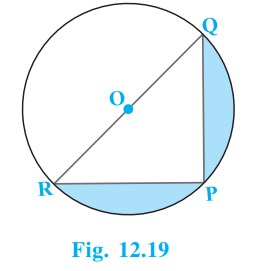
Solution ∠P is angle in a semi-circle subtended by the diameter. Therefore, it is a right angle. This implies that PQR is a right angled triangle with QR as the hypotenuse. By applying Pythagoras Theorem in PQR, we get QR2 = PQ2 + PR2 QR2 = 242 + 72 QR2 = 576 + 49 QR2 = 625 QR = 25 cm Radius of the circle = 25/2 = 12.5 cm Area of the semi-circle = πr2/2 = 22/7 × 12.52 × 1/2 = 11/7 × 156.25 = 245.54 cm2 Area of PQR = 1/2 × PQ × PR = 1/2 × 24 × 7 = 84 cm2 Area of the shaded region = Area of semi-circle - Area of PQR = 245.54 - 84 = 161.54 cm2 Hence, the area of shaded region = 161.54 cm2 2. Find the area of the shaded region in Fig. 12.20, if radii of the two concentric circles with centre O are 7 cm and 14 cm respectively and ∠ AOC = 40°. 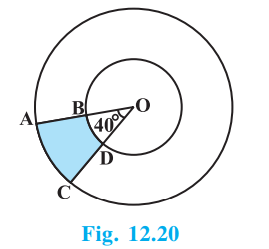
Solution Area of the smaller circle = πr2 = 22/7 × 72 = 22 × 7 = 154 cm2 Area of the bigger circle = πR2 = 22/7 × 142 = 22 × 2 × 14 = 616 cm2 Area of the sector BOD = (θ/360°) × πr2 = (40°/360°) × 154 = 1/9 × 154 = 154/9 cm2 Area of sector AOC = (θ/360°) × πR2 = 1/9 × 616 = 616/9 cm2 Area of the shaded region = Area of AOC - Area of BOD = 616/9 - 154/9 = 462/9 = 51.33 cm2 Hence, the area of the shaded region is 51.33 cm2. 3. Find the area of the shaded region in Fig. 12.21, if ABCD is a square of side 14 cm and APD and BPC are semicircles. 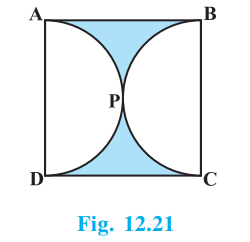
Solution AD = BC = 14 cm (Given) Since, APD and BPC are semicircles of same radius, they will also have equal areas. Area of the two semi-circles = 2 × (πr2)/2 = 22/7 × 14/2 × 14/2 = 22 × 7 = 154 cm2 Area of the square ABCD = s2 = 142 = 196 cm2 Area of the shaded region = Area of ABCD - Area of two semi-circles = 196 - 154 = 42 cm2 Hence, the area of the shaded region is 42 cm2. 4. Find the area of the shaded region in Fig. 12.22, where a circular arc of radius 6 cm has been drawn with vertex O of an equilateral triangle OAB of side 12 cm as centre. 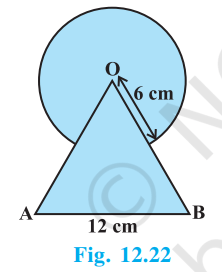
Solution Area of the circle = πr2 = 22/7 × 62 = 792/7 cm2 Area of the triangle = √3/4 × a2 = √3/4 × 122 = 36√3 cm2 Total area of the figure = Area of circle + Area of triangle = 792/7 + 36√3 cm2 The triangle and the circle have an overlapping area. Overlapping area = Area of the minor sector = (θ/360°) × πr2 = (60°/360°) × πr2 = 1/6 × 792/7 = 132√3 cm2 Area of the shaded region = Total area - Overlapping area = 792/7 + 36√3 - 132/7 = 660/7 + 36√3 cm2 Hence, the area of the shaded region is (660/7 + 36√3) cm2. 5. From each corner of a square of side 4 cm a quadrant of a circle of radius 1 cm is cut and also a circle of diameter 2 cm is cut as shown in Fig. 12.23. Find the area of the remaining portion of the square. 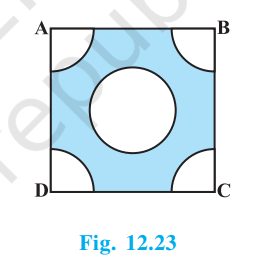
Solution Area of the square = s2 = 42 = 16 cm2 Area of the circle inside the square = πr2 = 22/7 × (2/2)2 = 22/7 × 1 × 1 = 22/7 cm2 Area of the quadrant of a circle in each corner = 4 × πr2 × 1/4 = 22/7 cm2 Area of shaded region = Area of square - Area of 4 quadrants - Area of the circle = 16 - 22/7 - 22/7 = 16 - 44/7 = (112 - 44)/7 = 68/7 cm2 Hence, the remaining area of the square is 68/7 cm2. 6. In a circular table cover of radius 32 cm, a design is formed leaving an equilateral triangle ABC in the middle as shown in Fig. 12.24. Find the area of the design. 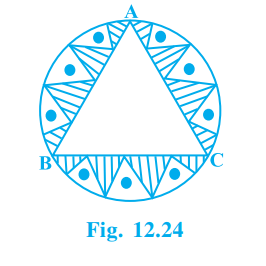
Solution We need to draw the media AD in triangle ABC. 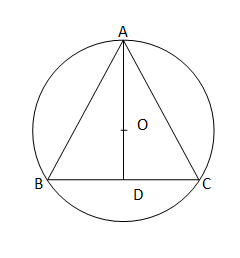
AO = 32 cm Since ABC is an equilateral triangle circumscribed in a circle, so the centre O will coincide with the triangle?s centroid. AO = 2/3 AD as centroid divides the median in 2: 3 ratio. AD = 3/2 AO = 3/2 × 32 = 48 cm We know that the median of an equilateral triangle is also a perpendicular bisector. Therefore, by using Pythagoras Theorem in ABD: AB2 = AD2 + BD2 AB2 = 482 + (AB/2)2 AB2 = 2304 + AB2/4 3/4 AB2 = 2304 AB2 = 768 × 4 AB2 = 3072 AB = 32√3 cm2 Area of the triangle = √3/4 × a2 = √3/4 × (32√3)2 = √3/4 × 3072 = 768√3 cm2 Area of the circle = πr2 = 22/7 × 322 = 22528/7 cm2 Area of the design = Area of the circle - Area of the triangle = 22528/7 - 768√3 cm2 Hence, the area of the design on the cover is (22528/7 - 768√3) cm2. 7. In Fig. 12.25, ABCD is a square of side 14 cm. With centres A, B, C and D, four circles are drawn such that each circle touch externally two of the remaining three circles. Find the area of the shaded region. 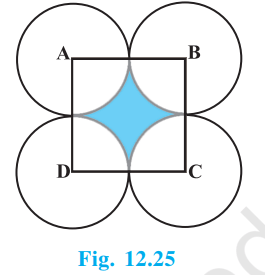
Solution Since, all angles are 90° in a square. Therefore, the square has 4 quadrants of equal circle. Area of one quadrant = 1/4 × πr2 Area of 4 quadrants = 4 × 1/4 × πr2 = 22/7 × (14/2)2 = 22 × 7 = 154 cm2 Area of the square = s2 = 142 = 196 cm2 Area of the shaded region = Area of square - Area of the 4 quadrants = 196 - 154 = 42 cm2 Hence, the area of the shaded region is 42 cm2. 8. Fig. 12.26 depicts a racing track whose left and right ends are semicircular. 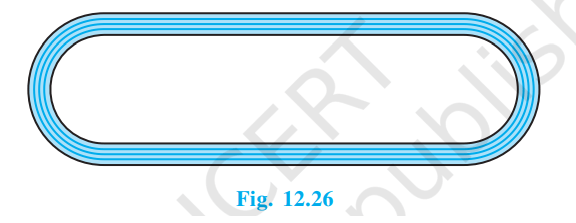
The distance between the two inner parallel line segments is 60 m and they are each 106 m long. If the track is 10 m wide, find :
Solution 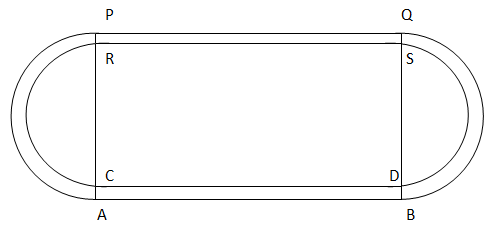
AB = CD = PQ = RS = 106 m CR = DS = 60 m AC = BD = PR = QS = 10 m (i) Radius of the semi-circles = CR/2 = 60/2 = 30 m Length of track from both semi-circles = 2πr = 2 × 22/7 × 30 = 1320/7 m Total distance of the inner track = Perimeter of the two semi-circles + RS + CD = 1320/7 + 106 + 106 = 1320/7 + 212 = (1320 + 1484)/7 = 2804/7 m (ii) Area of ABCD = AB × AC = 106 × 10 = 1060 m2 AB = PQ and AC = PR, so Area of PQRS = Area of ABCD = 1060 m2 Area of the 2 outer semi-circles = πR2 = 22/7 × (60 + 10 + 10)2/22 = 22/7 × 1600 = 35200/7 m2 Area of the 2 inner semi-circles = πr2 = 22/7 × 302 = 19800/7 m2 Area of the track = 2 × Area of ABCD + Area of 2 outer semi-circles - Area of 2 inner semi-circles = 2 × 1060 + 35200/7 - 19800/7 = 2120 + 15400/7 = 2120 + 2200 = 4320 m2 9. In Fig. 12.27, AB and CD are two diameters of a circle (with centre O) perpendicular to each other and OD is the diameter of the smaller circle. If OA = 7 cm, find the area of the shaded region. 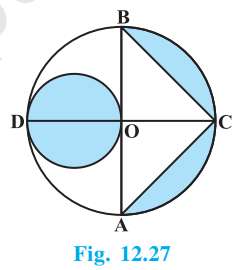
Solution It can be noted that OA, OB, OC and OD are radii of the circle and hence are equal. Area of the bigger circle = πR2 = 22/7 × 72 = 154 cm2 OD acts as the diameter for the smaller circle. Area of the smaller circle = πr2 = 22/7 × 7/2 × 7/2 = 77/2 cm2 AB = OB + OA = 7 + 7 = 14 cm Area of the triangle ABC = 1/2 × Base × Height = 1/2 × AB × OC = 1/2 × 14 × 7 = 49 cm2 Area of the shaded region = Area of the smaller circle + 1/2 × Area of bigger circle - Area of triangle ABC = 77/2 + 1/2 × 154 - 49 = 77/2 + 77 - 49 = 77/2 + 28 = (77 + 56)/2 = 133/2 = 66.5 cm2 Hence, the area of the shaded region is 66.5 cm2. 10. The area of an equilateral triangle ABC is 17320.5 cm2. With each vertex of the triangle as centre, a circle is drawn with radius equal to half the length of the side of the triangle (see Fig. 12.28). Find the area of the shaded region. (Use π = 3.14 and √3 = 1.73205) 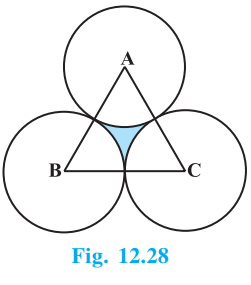
Solution Area of equilateral triangle = √3/4 × s2 17320.5 = √3/4 × s2 17320.5 = 1.73205/4 × s2 10000 × 4 = s2 40000 = s2 s = 200 cm Radius of each circle = s/2 = 100 cm Area of the minor sector of each circle = (θ/360°) × πr2 = (60°/360°) × 3.14 × 1002 = 1/6 × 31400 = 15700/3 cm2 Area of shaded region = Area of the triangle - 3 × Area of the minor sector of each circle = 17320.5 - 3 × 15700/3 = 17320.5 - 15700 = 1620.5 cm2 Hence, area of the shaded region is 1620.5 cm2. 11. On a square handkerchief, nine circular designs each of radius 7 cm are made (see Fig. 12.29). Find the area of the remaining portion of the handkerchief. 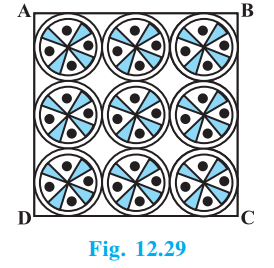
Solution Length of the side of handkerchief = 3 × Diameter of one circular design = 3 × 7(2) = 3 × 14 = 42 cm Area of the handkerchief = 422 = 1764 cm2 Area of one circular design = πr2 = 22/7 × 72 = 154 cm2 Remaining Area of the handkerchief = Area of handkerchief - 9 × Area of one circular design = 1764 - 9 × 154 = 1764 - 1386 = 378 cm2 12. In Fig. 12.30, OACB is a quadrant of a circle with centre O and radius 3.5 cm. If OD = 2 cm, find the area of the (i) quadrant OACB, (ii) shaded region. 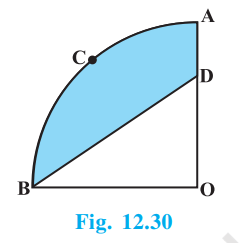
Solution (i) Area of the quadrant OACB = 1/4 × πr2 = 1/4 × 22/7 × (3.5)2 = 77/8 cm2 = 9.625 cm2 (ii) Area of the triangle OBD = 1/2 × base × height = 1/2 × OB × OD = 1/2 × 3.5 × 2 = 3.5 cm2 Area of the shaded region = Area of the quadrant OACB - Area of the triangle OBD = 9.625 - 3.5 = 6.125 cm2 13. In Fig. 12.31, a square OABC is inscribed in a quadrant OPBQ. If OA = 20 cm, find the area of the shaded region. (Use π = 3.14) 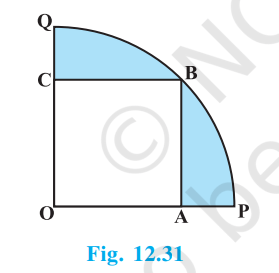
Solution Join O with B. 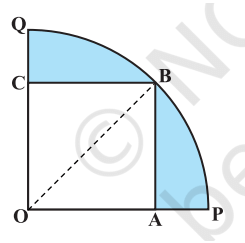
OAB is a right triangle, so by applying Pythagoras Theorem, we get OB2 = OA2 + AB2 OB2 = 202 + 202 OB2 = 400 + 400 OB2 = 800 OB = 20√2 cm OB is the radius of the given quadrant of a circle. Area of the quadrant = 1/4 × πr2 = 1/4 × 3.14 × (20√2)2 = 1/4 × 3.14 × 800 = 628 cm2 Area of the square OABC = OA2 = 202 = 400 cm2 Area of the shaded region = Area of the quadrant - Area of the square = 628 - 400 = 228 cm2 Hence, the area of the shaded region is 228 cm2. 14. AB and CD are respectively arcs of two concentric circles of radii 21 cm and 7 cm and centre O (see Fig. 12.32). If ∠AOB = 30°, find the area of the shaded region. 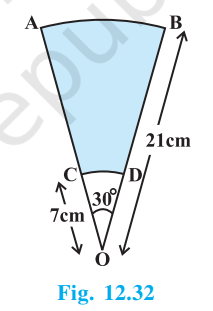
Solution Area of the sector of the bigger circle = (θ/360°) × πR2 = (30°/360°) × 22/7 × 212 = 1/12 × 22/7 × 441 = 231/2 cm2 Area of the sector of the smaller circle = (θ/360°) × πr2 = (30°/360°) × 22/7 × 72 = 1/12 × 154 = 77/6 cm2 Area of the shaded region = Area of sector with radius R - Area of sector with radius r = 231/2 - 77/6 = (693 - 77)/6 = 616/6 = 308/3 cm2 Hence, the area of the shaded region is 308/3 cm2. 15. In Fig. 12.33, ABC is a quadrant of a circle of radius 14 cm and a semicircle is drawn with BC as diameter. Find the area of the shaded region. 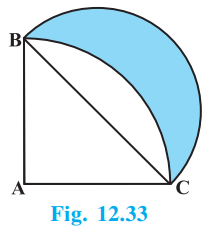
Solution Area of the quadrant = 1/4 × πR2 = 1/4 × 22/7 × 142 = 154 cm2 Area of the triangle ABC = 1/2 × base × height = 1/2 × 14 × 14 = 98 cm2 Area of the corresponding segment of the quadrant = Area of quadrant - Area of triangle = 154 - 98 = 56 cm2 By applying Pythagoras Theorem in ABC, we get BC2 = AB2 + AC2 BC2 = 142 + 142 BC2 = 196 + 196 BC2= 392 BC = 14√2 cm Area of the semi-circle = 1/2 × πr2 = 1/2 × 22/7 × (14√2/2)2 = 154 cm2 Area of the shaded region = Area of Semi-circle - Area of the segment = 154 - 56 = 98 cm2 Hence, the area of the shaded region is 98 cm2. 16. Calculate the area of the designed region in Fig. 12.34 common between the two quadrants of circles of radius 8 cm each. 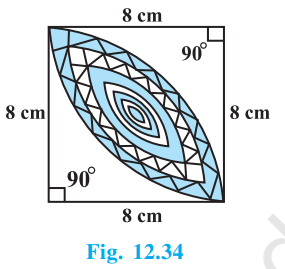
Solution 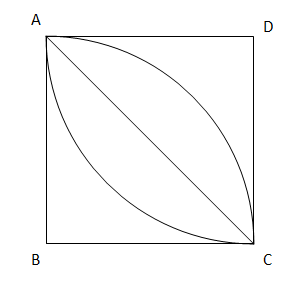
Since, both the quadrants have the same radius. Therefore, their area will be equal. This implies that area of their corresponding segments will also be equal. Area of triangle ABC = 1/2 × Base × Height = 1/2 × 8 × 8 = 32 cm2 Area of each quadrant = 1/4 × πr2 = 1/4 × 22/7 × 82 = 352/7 cm2 Area of each segment = Area of quadrant - Area of triangle = 352/7 - 32 = (352 - 224)/7 = 128/7 cm2 Area of the design = 2 × Area of one segment = 2 × 128/7 = 256/7 cm2 Hence, the area of the design is 256/7 cm2. |
 For Videos Join Our Youtube Channel: Join Now
For Videos Join Our Youtube Channel: Join Now
Feedback
- Send your Feedback to [email protected]
Help Others, Please Share









